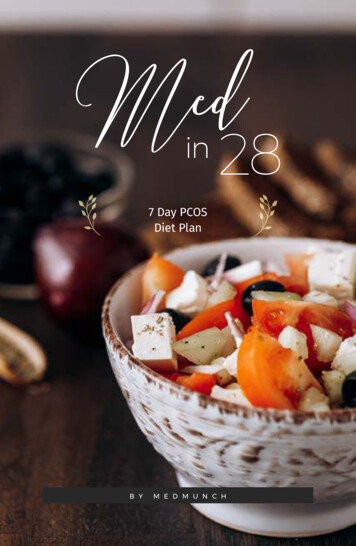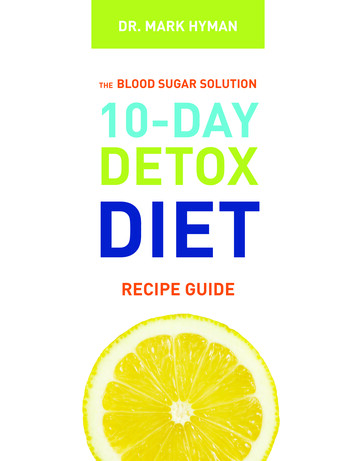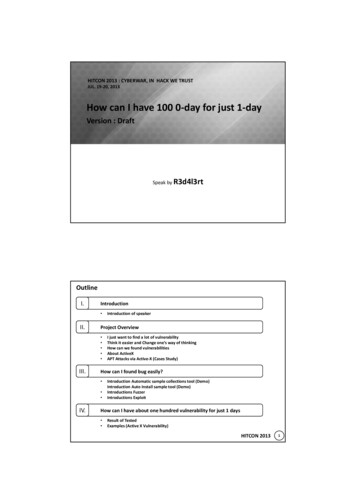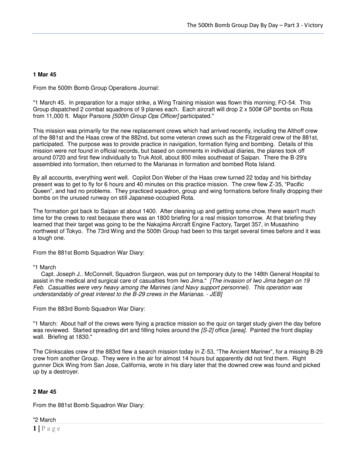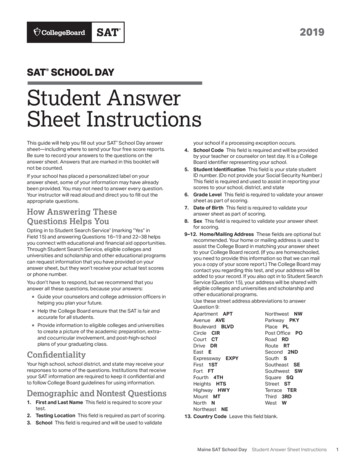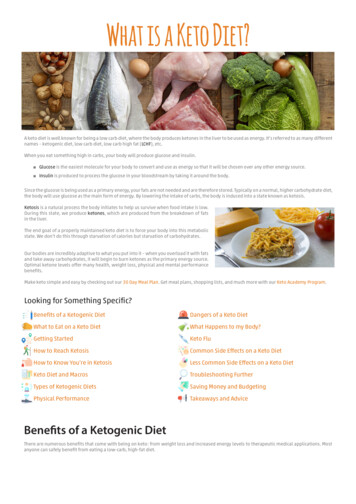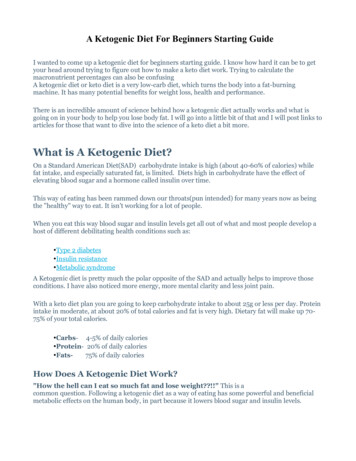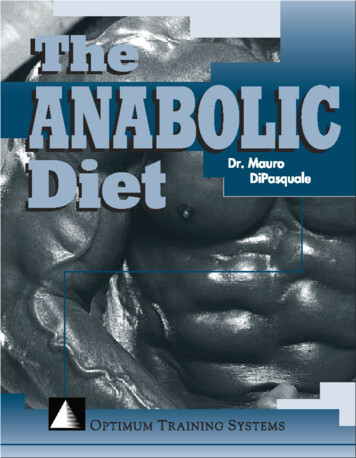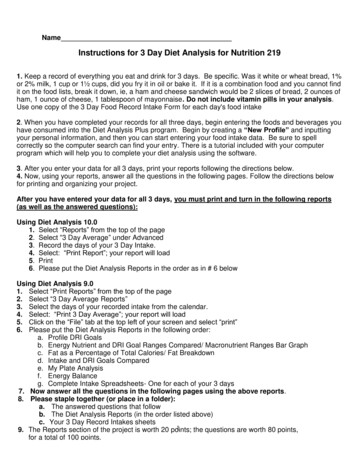
Transcription
NameInstructions for 3 Day Diet Analysis for Nutrition 2191. Keep a record of everything you eat and drink for 3 days. Be specific. Was it white or wheat bread, 1%or 2% milk, 1 cup or 1½ cups, did you fry it in oil or bake it. If it is a combination food and you cannot findit on the food lists, break it down, ie, a ham and cheese sandwich would be 2 slices of bread, 2 ounces ofham, 1 ounce of cheese, 1 tablespoon of mayonnaise. Do not include vitamin pills in your analysis.Use one copy of the 3 Day Food Record Intake Form for each day's food intake2. When you have completed your records for all three days, begin entering the foods and beverages youhave consumed into the Diet Analysis Plus program. Begin by creating a “New Profile” and inputtingyour personal information, and then you can start entering your food intake data. Be sure to spellcorrectly so the computer search can find your entry. There is a tutorial included with your computerprogram which will help you to complete your diet analysis using the software.3. After you enter your data for all 3 days, print your reports following the directions below.4. Now, using your reports, answer all the questions in the following pages. Follow the directions belowfor printing and organizing your project.After you have entered your data for all 3 days, you must print and turn in the following reports(as well as the answered questions):Using Diet Analysis 10.01. Select “Reports” from the top of the page2. Select “3 Day Average” under Advanced3. Record the days of your 3 Day Intake.4. Select: “Print Report”; your report will load5. Print6. Please put the Diet Analysis Reports in the order as in # 6 belowUsing Diet Analysis 9.01. Select “Print Reports” from the top of the page2. Select “3 Day Average Reports”3. Select the days of your recorded intake from the calendar.4. Select: “Print 3 Day Average”; your report will load5. Click on the “File” tab at the top left of your screen and select “print”6. Please put the Diet Analysis Reports in the following order:a. Profile DRI Goalsb. Energy Nutrient and DRI Goal Ranges Compared/ Macronutrient Ranges Bar Graphc. Fat as a Percentage of Total Calories/ Fat Breakdownd. Intake and DRI Goals Comparede. My Plate Analysisf. Energy Balanceg. Complete Intake Spreadsheets- One for each of your 3 days7. Now answer all the questions in the following pages using the above reports.8. Please staple together (or place in a folder):a. The answered questions that followb. The Diet Analysis Reports (in the order listed above)c. Your 3 Day Record Intakes sheets19. The Reports section of the project is worth 20 points;the questions are worth 80 points,for a total of 100 points.
3 Day Food Record Intake SheetsKeep a record of everything you eat and drink for 3 days. Be specific. Was it white orwheat bread, 1% or 2% milk, 1 cup or 1½ cups, did you fry it in oil or bake it. If it is acombination food that you are unable to find in the Diet Analysis software, you mayneed to break it down, ie, a ham and cheese sandwich would be 2 slices of bread, 2ounces of ham, 1 ounce of cheese, 1 tablespoon of mayonnaise. Do not includevitamin pills or supplements in your analysis.Day 1 Date:Amount consumed Description of food or ingredient How preparedEx: 1 ½ cupsHoney-nut cheeriosNo preparation2
Day 2 Date:Amount consumed Description of food or ingredient How preparedEx: 1 ½ cupsHoney-nut cheeriosNo preparation3
Day 3 Date:Amount consumed Description of food or ingredient How preparedEx: 1 ½ cupsHoney-nut cheeriosNo preparation4
SELF STUDY 1: EVALUATE YOUR CARBOHYDRATE INTAKETake a look at your report. Your 3 days of intake are averaged for you and the resultsare the Intake vs Goals Report. Questions that refer to your “average daily intake”should be based on the number listed under “Intake” on your Intake vs Goals Report inthe first category under “Energy”. (in Diet Analysis 9, this is referred to as “Intake andDRI Goals Compared”)1. What is your average daily intake for carbohydrate? This number is listedunder “Intake” on the “Intake vs Goals” report under the category of “Energy”. (Thisreport is called Intake and DRI Goals Compared on Diet Analysis 9)2. How many kcalories does this represent?( 1 gram of carbohydrate contributes 4 kcalories, so multiply your grams of carbohydrate by 4.)3. What percent of your total kcalorie intake is contributed by carbohydrate?(This is on the Macronutrient Ranges bar graph. On Diet Analysis 9, it is calledEnergy Nutrient Intake and DRI Goal Ranges Compared which is in the small box on its own page)4. The recommendation for carbohydrate is that 45-65% of your daily kcalories shouldcome from carbohydrate. Based on your answer in number 3, is your carbohydraterange within that 45-65% range?Yes or No5. From the list below, circle the whole grains that you consumed during the 3 days thatyou recorded.Whole GrainsWhole wheat breadoatmealcracked wheat breadwhole cornmeal bulgurbuckwheatwhole grain pastapopcornbrown ricewild ricewhole wheat couscousgraham flourryeAll branCold CerealCheerios Granola or Muesli Grape-nuts Nutri-grain Raisin Bran Bran flakes Mini WheatsShredded WheatTotal Wheaties Wheat Chex Wheat germKashi Go LeanHot CerealOat bran Oatmeal Quaker Multigrain Ralston High Fiber WheatenaOther whole grainIf you did not eat any whole grains, list 3 whole grains which you could include in your diet, ,6. What is your DRI recommendation for fiber?7. How many grams of fiber did you consume on an average day?(This is on your Intake vs Goals report under Carbohydrate)8. Compare your intake with your DRI recommendation for fiber.How many grams of fiber were you over or under your DRI recommendation?gramsover or under (circle one)5
SELF STUDY 1: EVALUATE YOUR CARBOHYDRATE INTAKE (continued)Continue to evaluate your fiber intake.9. a. If you consumed less than your DRI, list specifically what foods you couldinclude in your diet to make up the difference and meet your DRI for fiber.b. List how many grams of fiber each of your suggestions will add. Forexample, if you only ate 15 grams, you need to add 10 grams to make up thedifference. An example might be: 1 cup of raspberries-8 grams, 2 cups ofpopcorn-2 grams. Make sure you list foods you would actually eat (and don’tuse my examples).FoodAmountGramsTotal Grams Fiber you need to eatto meet your DRI. How might a low fiber diet impact your health?9c. If you consumed your DRI of fiber or more, great job!Now review all 3 days of your spreadsheets, circle the top 3 foods highest in fiber youconsumed over the 3 days, and list them here and the amount of fiber in each food item.FoodGramsFoodGramsFoodGramsHow might a high fiber diet benefit your health?10. Another dietary goal is that no more than 10% of your total kcalories should comefrom refined and other processed sugars and foods high in added sugars. To assessyour intake against this standard, review your 3 day intake and identify and circlethe foods high in processed (simple) sugar and list them below.Include: Foods containing mostly concentrated simple carbohydrates such as sugar,candy, cookies, cakes, pie, doughnuts, pastry, soda pop, sweetened beverages,lemonade, sweetened or flavored iced tea, ice cream, honey, molasses, syrup, jam,jelly, and high sugar cereals (cereals with more than 10 grams of sugar per serving).Do not list milk, fruit, natural juices; just list foods containing processed sugars.11. What other food choices could you substitute for your high sugar foods to loweryour sugar intake?6
SELF-STUDY 2: FAT1.What is your average daily intake for total grams of fat? (This is underIntake, under the category of Energy, on your Intake vs Goals report in DA 10, which is calledIntake and DRI Goals Compared in DA 9; DO NOT USE THE SATURATED FAT NUMBER)2. How many kcalories does this represent? (Remember, 1 gram of fat contributes 9kcalories per gram)3. What percent of your total kcalorie intake is contributed by fat?(This is on the Macronutrient Ranges bar graph in DA 10; In Diet Analysis 9, it is calledEnergy Nutrient Intake and DRI Goal Ranges Compared.)The recommendation for fat intake is that no more that 20-35% of your dailykcalories should come from fat. Did you consume more than 35% of your intakefrom fat based on your answer above? (yes or no)4.Review your Fat Breakdown report. (called Fat as Percentage of Total Calories in DA 9)What percent of your fat intake is saturated fat? Is it more than 10% ofyour total kcalories? (yes or no)5. Regardless of your saturated fat intake, look over your food records; what specificfoods could you cut down on or eliminate to decrease your saturated fat intake?What “heart healthier” foods could you replace them with?How might a diet high in saturated fat affect your health?6. How much essential fatty acid do you consume? Refer to your Intake vsGoals report under “Essential Fatty Acids”. The percentage number is the number tothe right of the yellow bar graph.Omega-6 Linoleic grams What % of your DRI did you meet?Omega-3 Linolenic grams What % of your DRI did you meet?If you did not meet your DRI goal (if your intake was less than 80%) for either of theabove, what foods could you add to your diet to meet your needs for essential fattyacid?7. What is your average daily intake for cholesterol?grams8. If your intake is over 300 mg, what foods could you cut down on or eliminate to bringyour cholesterol intake within suggested limits?If your intake is less than 300 mg, list the top 2 foods highest in cholesterol youconsumed over the 3 days.7
SELF-STUDY 3: PROTEIN1. What is your average daily intake in grams for protein?(Refer to your Intake vs Goals report, called Intake and DRI Goals Compared in DA 9)2. How many kcalories does this represent? (Remember, 1 gram of protein contributes4 kcalories.)3. What percent of your total kcalorie intake is contributed by protein?(This is on the Macronutrient Ranges bar graph, called Energy Nutrient Intake and DRI GoalRanges Compared on DA 9)4. Was your protein intake in the range of the recommendation that 10-35% of yourtotal kcalorie intake should come from protein? (yes or no).If your protein intake is above or below the recommended 10-35%, what foods couldyou consume more of—or less of—to help it meet the recommendation?5. Now calculate your RDA for grams of protein. (See page 193 of your text). Start bydividing your weight in pounds by 2.2 to determine your weight in kilograms kg. Then multiply your weight in kilograms by 0.8. grams.This number represents your protein RDA.6. What percent of your DRI did you consume? (This number is theone to the right of the yellow arrow or bar on your Intake vs Goals report)SELF STUDY 4: Evaluate Your Health RiskWhat weight is appropriate for you? When physical health alone is considered, a widerange of weights is acceptable for a person of a given height. Within the safe range, thechoice of a weight is up to the individual.1. Determine whether your current weight is appropriate for your height.Height: in (or cm) Weight: lb (or kg)2. Locate your BMI on the chart and record it.3. Circle your BMI Category:UnderweightHealthy weightOverweightObese4. Does your body weight fit in the healthy weight range? (yes or no)8
SELF STUDY 4: Evaluate Your Health Risk (cont)If you are underweight according to the table on the inside back cover of the text and yourBMI is below 19, you may need to gain weight for your health’s sake. If your weight is overthe acceptable weight range your BMI value may be associated with an increased risk ofdisease.5. The distribution of body fat may be more critical than the amount of fat alone.Determine whether your fat distribution is associated with health risks. Record your waist measurement: in (or cm)Women with a circumference of greater than 35 inches and men with a circumference ofgreater than 42 inches are at a high risk for obesity-related health problems, regardless ofyour BMI.6.Other risk factors for chronic disease: Circle your response. Do you have a personal or family history of heart disease Are you a male older than 45 or a postmenopausal female Do you smoke cigarettes? Do you have a sedentary lifestyle? Have you been diagnosed with high blood pressure Abnormal blood lipid profile Do you have oThe higher your BMI and waist measurement, coupled with multiple risk factors,the more likely your overall health will benefit from weight loss.6. Look at your Intake vs Goals Report for kcalories under the Energy category.What percent of your DRI for kcalories did you consume?Did you exceed your estimated daily intake for kcalories or were you below yourestimated daily calorie intake?Circle one: exceed below8. If your kcalorie intake was 120% of your DRI, what effect could your eating habitshave on your weight over several months, or years, if you continued to overeatmore than the recommended calorie level?If your kcalorie intake was 80% or less of your DRI, what effect could your eatinghabits have on your weight over several months, or years, if you continued to eatless than the recommended calorie level?9. List your usual physical activities, sports and exercise, minutes per day and timesper week.If you are not physically active, how could you incorporate physical activity into yourdaily life?9
SELF STUDY 5: VITAMINSReview your average daily percent of your vitamin goals compared to your DRI. This isthe number to the right of the yellow bar graph on your Intake vs. Goals Report. Inthe table below, note the following:1. Column 1: list the percentage of your recommended intake that you consumed forthe vitamins and minerals from your Intake vs. Goals Report. (This is the number to the rightof the yellow bar or arrow; Do not list the DRI number)2. Column 2: if your intake was less than 80% for any of the nutrients, list 3 specificfoods rich in that nutrient you would consume to include more of this nutrient in yourdiet. List foods not included on your 3 Day Food Record.NutrientPercent ofyour DRI(1 pt each)For those nutrients less than 80%, list 3 specificfoods rich in the nutrient you would consume toinclude more of this nutrient in your diet. (1 pteach)ThiaminRiboflavinNiacinVitamin B6Vitamin B12FolateVitamin CVitamin DVitamin A (RAE)Vitamin E (alphatocopherol)10
SELF STUDY 6: MINERALSReview your average daily percent of your mineral goals compared to your DRI. This isthe number to the right of the yellow bar graph on your Intake vs. Goals Report. In thetable below, note the following:1.a. Column 1: list the percentage of your recommended intake that you consumed forthe vitamins and minerals from your Intake vs. Goals Report. (This is the number to the rightof the yellow bar or arrow; Do not list the DRI number)1.b. Column 2: if your intake was less than 80% for any of the nutrients, list 3 specificfoods rich in that nutrient you would consume to include more of this nutrient in yourdiet. List foods not included on your 3 Day Food Record.NutrientPercentof yourDRIFor those nutrients less than 80%, list 3 specific foodsrich in the nutrient you would consume to include moreof this nutrient in your diet. (1 pt each)(1 pt each)CalciumIronMagnesiumPotassiumZinc2. Compare your average intake with your DRI for sodium. What percent of yourrecommended intake of sodium did you consume?3. Review your food records and circle the top 3 foods highest in sodium over thepast 3 days.List them here and the milligrams of sodium in each:Food mgFood mgFood mgIn what ways could you change your diet to decrease your sodium intake if youconsumed more than 200% of your goal? (What could you consume less of to decreaseyour sodium intake?11
Overall Review1. How do your current food habits impact your overall nutrient intake?2. How might your habits affect your overall health and potential for chronic disease?3. Do you currently take a vitamin or mineral supplement?After completing the vitamin/mineral exercise on the previous page, do you feel youcould benefit from a supplement?4. Have you made any changes in your diet or lifestyle since taking this class toimprove your nutrition intake and what are they?If you have not made any changes, list 3 changes you could make to improve youroverall nutrition and health status?5. What were you most surprised about regarding your intake after completing thisassignment?12
program which will help you to complete your diet analysis using the software. 3. After you enter your data for all 3 days, print your reports following the directions below. 4. Now, using your reports, answer all the questions in the following pages. Follow the d
